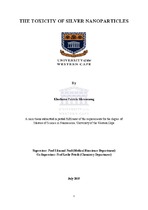The toxicity of silver nanoparticles
Abstract
Unavailability and contamination of available water resources are major factors contributing to adverse health conditions worldwide. AgNPs present a potential strategy for water purification; however, their ability to accumulate in organs such as the kidneys, lungs and spleen is a possible source of toxicity. This study investigates the toxicity of AgNPs to Saccharomyces cerevisiae (S. cerevisiae). S. cerevisiae is an excellent model organism for assessing toxic compounds that affect eukaryotic organisms due to their ease of cultivation. AgNPs were prepared by photo-reduction of silver nitrate with OSRAM Vitalux lamp (300 W and 230 V) in the presence of stabilizing agents such as polyvinylpyrrolidone and citric acid, yielding AgNPs. The effects of varying the concentration of the stabilizing agent, time of exposure to the light source, and pH were investigated. The formation of AgNPs was analysed by ultra-violet spectroscopy (UV-Vis) and transmission electron microscope techniques. The results showed that the AgNPs absorbed ultra-violet radiation between 400 and 500 nm and TEM images showed the particles to be both spherical and needle-like in shape. The shapes of the AgNPs were largely dependent on the synthesis method applied. The toxicity of AgNPs was assessed using metabolic activity of yeast cells as biomarker andmonitored with of the chromogenic assay, XTT. S. cerevisiae was introduced into different concentrations of AgNPs and incubated at 37oC for 72 h. After the incubation, XTT assay was performed to assess the cell viability. The XTT results showed that high concentration of AgNPs (100 µg/mL) inhibited the growth of S. cerevisiae. The synthesis of AgNPs and theassessment of their toxicity on S. cerevisiae was thus undertaken and established in this work.

